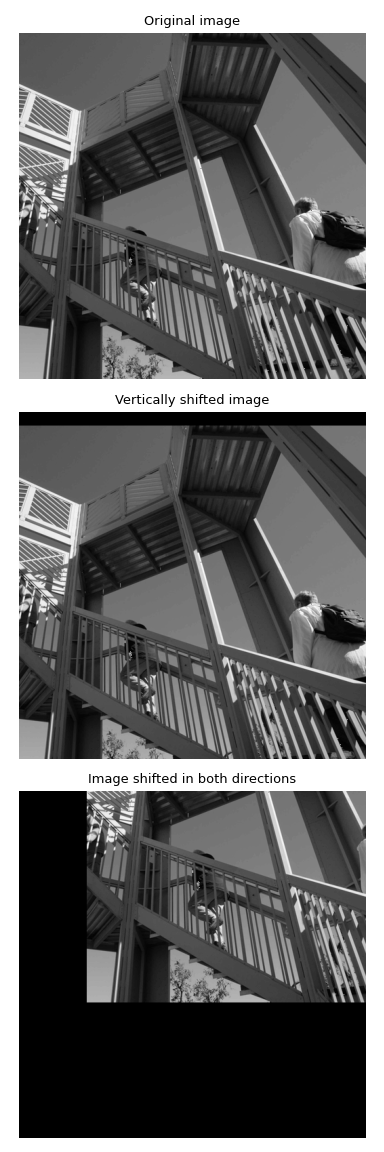shift#
- scipy.ndimage.shift(input, shift, output=None, order=3, mode='constant', cval=0.0, prefilter=True)[source]#
Shift an array.
The array is shifted using spline interpolation of the requested order. Points outside the boundaries of the input are filled according to the given mode.
- Parameters:
- inputarray_like
The input array.
- shiftfloat or sequence
The shift along the axes. If a float,
shiftis the same for each axis. If a sequence,shiftshould contain one value for each axis.- outputarray or dtype, optional
The array in which to place the output, or the dtype of the returned array. By default an array of the same dtype as input will be created.
- orderint, optional
The order of the spline interpolation, default is 3. The order has to be in the range 0-5.
- mode{‘reflect’, ‘grid-mirror’, ‘constant’, ‘grid-constant’, ‘nearest’, ‘mirror’, ‘grid-wrap’, ‘wrap’}, optional
The mode parameter determines how the input array is extended beyond its boundaries. Default is ‘constant’. Behavior for each valid value is as follows (see additional plots and details on boundary modes):
- ‘reflect’ (d c b a | a b c d | d c b a)
The input is extended by reflecting about the edge of the last pixel. This mode is also sometimes referred to as half-sample symmetric.
- ‘grid-mirror’
This is a synonym for ‘reflect’.
- ‘constant’ (k k k k | a b c d | k k k k)
The input is extended by filling all values beyond the edge with the same constant value, defined by the cval parameter. No interpolation is performed beyond the edges of the input.
- ‘grid-constant’ (k k k k | a b c d | k k k k)
The input is extended by filling all values beyond the edge with the same constant value, defined by the cval parameter. Interpolation occurs for samples outside the input’s extent as well.
- ‘nearest’ (a a a a | a b c d | d d d d)
The input is extended by replicating the last pixel.
- ‘mirror’ (d c b | a b c d | c b a)
The input is extended by reflecting about the center of the last pixel. This mode is also sometimes referred to as whole-sample symmetric.
- ‘grid-wrap’ (a b c d | a b c d | a b c d)
The input is extended by wrapping around to the opposite edge.
- ‘wrap’ (d b c d | a b c d | b c a b)
The input is extended by wrapping around to the opposite edge, but in a way such that the last point and initial point exactly overlap. In this case it is not well defined which sample will be chosen at the point of overlap.
- cvalscalar, optional
Value to fill past edges of input if mode is ‘constant’. Default is 0.0.
- prefilterbool, optional
Determines if the input array is prefiltered with
spline_filterbefore interpolation. The default is True, which will create a temporary float64 array of filtered values iforder > 1. If setting this to False, the output will be slightly blurred iforder > 1, unless the input is prefiltered, i.e. it is the result of callingspline_filteron the original input.
- Returns:
- shiftndarray
The shifted input.
See also
affine_transformAffine transformations
Notes
For complex-valued input, this function shifts the real and imaginary components independently.
Added in version 1.6.0: Complex-valued support added.
Array API Standard Support
shifthas experimental support for Python Array API Standard compatible backends in addition to NumPy. Please consider testing these features by setting an environment variableSCIPY_ARRAY_API=1and providing CuPy, PyTorch, JAX, or Dask arrays as array arguments. The following combinations of backend and device (or other capability) are supported.Library
CPU
GPU
NumPy
✅
n/a
CuPy
n/a
✅
PyTorch
✅
⛔
JAX
⚠️ no JIT
⛔
Dask
⚠️ computes graph
n/a
See Support for the array API standard for more information.
Examples
Import the necessary modules and an exemplary image.
>>> from scipy.ndimage import shift >>> import matplotlib.pyplot as plt >>> from scipy import datasets >>> image = datasets.ascent()
Shift the image vertically by 20 pixels.
>>> image_shifted_vertically = shift(image, (20, 0))
Shift the image vertically by -200 pixels and horizontally by 100 pixels.
>>> image_shifted_both_directions = shift(image, (-200, 100))
Plot the original and the shifted images.
>>> fig, axes = plt.subplots(3, 1, figsize=(4, 12)) >>> plt.gray() # show the filtered result in grayscale >>> top, middle, bottom = axes >>> for ax in axes: ... ax.set_axis_off() # remove coordinate system >>> top.imshow(image) >>> top.set_title("Original image") >>> middle.imshow(image_shifted_vertically) >>> middle.set_title("Vertically shifted image") >>> bottom.imshow(image_shifted_both_directions) >>> bottom.set_title("Image shifted in both directions") >>> fig.tight_layout()
